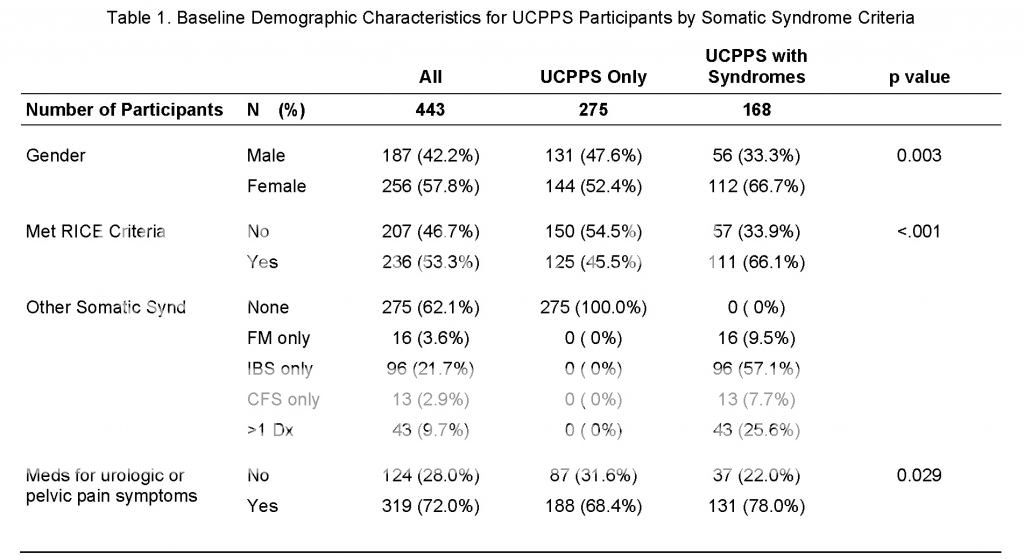(From AUA2013 Annual Meeting http://www.aua2013.org/abstracts )

Moderated Poster
Funding: NIH/NIDDK MAPP Research Network grants
443: Non-Urological Syndromes and Severity of Urological Pain Symptoms: Baseline Evaluation of the National Institutes of Health Multidisciplinary Approach to Pelvic Pain Study
John Krieger; Alisa Stephens; J. Richard Landis; Niloofar Afari; Gerald Andriole; J. Quentin Clemens; Karl Kreder; H. Henry Lai; Sean Mackey; Larissa Rodriguez; Anthony Schaeffer; David Williams
Abstract: 443
Introduction and Objectives
We report data from the Multidisciplinary Approach to Pelvic Pain Study (MAPP) network to: characterize participants having either primarily pelvic pain symptoms or unexplained non-urological somatic syndromes in addition to pelvic pain, with respect to symptoms, psychosocial factors, quality of life, and healthcare utilization.
Methods
This multi-site study evaluated men and women with urological pain, including: predominant symptoms, symptom duration and severity, non-urologic syndromes, psychosocial factors, and healthcare utilization in individuals presenting with chronic pelvic pain syndromes.
Results
Of 443 participants with urological symptoms, 168 (38%) had symptoms of non-urological syndromes: 96 (22%) irritable bowel syndrome, 16 (4%) fibromyalgia, 13 (3%) chronic fatigue syndrome, and 43 (10%) with multiple syndromes.
Among 256 females, 112 (44%) had non-urological syndromes compared to 56 (30%) of 187 males (p = 0.003).
Patients with non-urological syndromes were younger at diagnosis, had more severe urological symptoms, worse quality of life, and more frequent depression and anxiety.
Of 275 patients with urological symptoms only, 188 (68%) were taking prescription medications for their symptoms, compared to 131 (78%) of 168 patients with non-urological syndromes (p = 0.029).
Of 443 participants, 236 (53%) met RICE criteria. Among the 236 participants who met RICE criteria, 111 (47%) had non-urological syndromes compared to 57 (28%) of 207 patients not meeting RICE criteria with non-urological syndromes (p < 0.001).
Conclusions
Non-urological syndromes represent important phenotypic characteristics in chronic pelvic pain.
Since the prevalence of non-urological syndromes was substantially higher in women, this suggests that there may be gender-specific factors which contribute to the urologic pelvic pain symptoms.
Patients with both urological and non-urological syndromes had more severe symptoms, decreased quality of life, and higher rates of depression and anxiety.
Patients who meet RICE criteria were more likely to have non-urological syndromes and more severe symptoms.
Date & Time: May 5, 2013 01:00 PM
Session Title: General & Epidemiological Trends & Socioeconomics: Qualify of Life
Sources of Funding: NIH/NIDDK MAPP Research Network grants
----
Sunday, May 05, 2013 1:00 PM-3:00 PM
SDCC: Room 10
General & Epidemiological Trends & Socioeconomics: Qualify of Life

